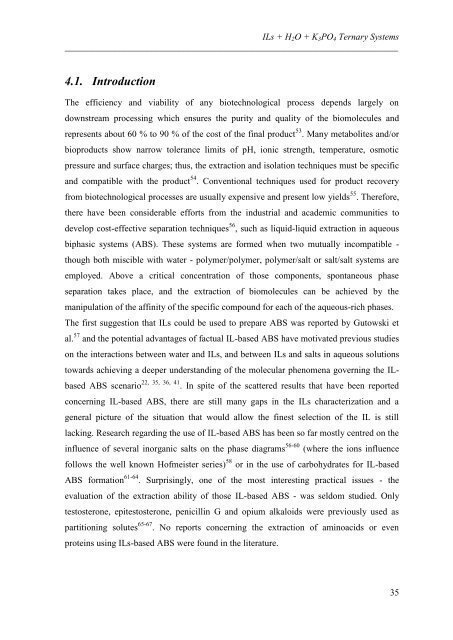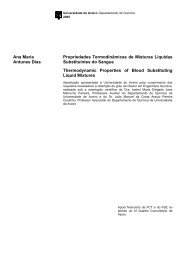Catarina Maia Seco Seiça Neves Sistemas Aquosos Bifásicos com ...
Catarina Maia Seco Seiça Neves Sistemas Aquosos Bifásicos com ...
Catarina Maia Seco Seiça Neves Sistemas Aquosos Bifásicos com ...
You also want an ePaper? Increase the reach of your titles
YUMPU automatically turns print PDFs into web optimized ePapers that Google loves.
ILs + H2O + K3PO4 Ternary Systems<br />
_________________________________________________________________________<br />
4.1. Introduction<br />
The efficiency and viability of any biotechnological process depends largely on<br />
downstream processing which ensures the purity and quality of the biomolecules and<br />
represents about 60 % to 90 % of the cost of the final product 53 . Many metabolites and/or<br />
bioproducts show narrow tolerance limits of pH, ionic strength, temperature, osmotic<br />
pressure and surface charges; thus, the extraction and isolation techniques must be specific<br />
and <strong>com</strong>patible with the product 54 . Conventional techniques used for product recovery<br />
from biotechnological processes are usually expensive and present low yields 55 . Therefore,<br />
there have been considerable efforts from the industrial and academic <strong>com</strong>munities to<br />
develop cost-effective separation techniques 56 , such as liquid-liquid extraction in aqueous<br />
biphasic systems (ABS). These systems are formed when two mutually in<strong>com</strong>patible -<br />
though both miscible with water - polymer/polymer, polymer/salt or salt/salt systems are<br />
employed. Above a critical concentration of those <strong>com</strong>ponents, spontaneous phase<br />
separation takes place, and the extraction of biomolecules can be achieved by the<br />
manipulation of the affinity of the specific <strong>com</strong>pound for each of the aqueous-rich phases.<br />
The first suggestion that ILs could be used to prepare ABS was reported by Gutowski et<br />
al. 57 and the potential advantages of factual IL-based ABS have motivated previous studies<br />
on the interactions between water and ILs, and between ILs and salts in aqueous solutions<br />
towards achieving a deeper understanding of the molecular phenomena governing the IL-<br />
based ABS scenario 22, 35, 36, 41 . In spite of the scattered results that have been reported<br />
concerning IL-based ABS, there are still many gaps in the ILs characterization and a<br />
general picture of the situation that would allow the finest selection of the IL is still<br />
lacking. Research regarding the use of IL-based ABS has been so far mostly centred on the<br />
influence of several inorganic salts on the phase diagrams 56-60 (where the ions influence<br />
follows the well known Hofmeister series) 58 or in the use of carbohydrates for IL-based<br />
ABS formation 61-64 . Surprisingly, one of the most interesting practical issues - the<br />
evaluation of the extraction ability of those IL-based ABS - was seldom studied. Only<br />
testosterone, epitestosterone, penicillin G and opium alkaloids were previously used as<br />
partitioning solutes 65-67 . No reports concerning the extraction of aminoacids or even<br />
proteins using ILs-based ABS were found in the literature.<br />
35



